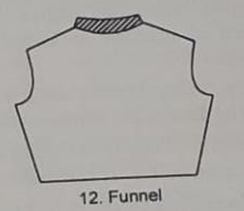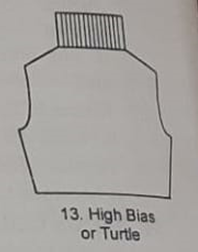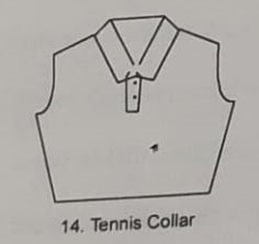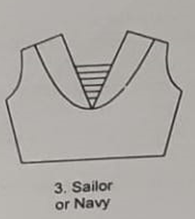Sleeves
- Sleeve is a Dutch word
derived from word slip.
- It is a part of garments
that proper the arms covers or grow passes arms in a slip in that
particular fabric.
- It is a non-essential part
but can be consider as designing part.
- It is the characteristics
of fashion in a dress which has many variations in every country and various
time periods.
- It is a fashionable attire
and the part of dress for both male or females.
- In early centuries the
length of shoulder is increased to create sleeves but after fifteenth
century sleeves created their space an in fashion industry and turned up
the whole fashion.
- There are various length
of sleeves that is it can be short, elbow, 3/4th, fall, 7/8th,
wrist.
- It is a designing part
which requires special tailors for making it, like:- gathered sleeve,
tulip sleeve, Patel sleeve, bell shaped, flared sleeve etc.
- Sometimes access of fabric
is also used to decorate the sleeve.
- Various fabrics can also
be used from thin, glossy, thick etc.
Types of Sleeve
1.Set-In-Sleeve:-It is a very
common sleeve which required both bodice block and sleeve block where armholes
are attached together.
·
Arm is
most mobile part of body which required free movements.
·
Set -in -Sleeve design to fit the armhole smoothly.
2.Set-Out-Sleeves/Extended Sleeves:
- Sleeves and the body of any garment is combine together.
·
It requires more fabric.
·
There are lots of sleeves which a sewn together
without set in method.
·
The sleeves does not required separate sleeve
pattern for cutting and generally are extended from shoulder.
·
There are mainly various types of extended
sleeves.
1.Dolman/Batwing Sleeve:- There
is usually no seam connecting the sleeve to the bodice, but is instead cut as
one with the bodice.
·
This sleeve style is popular on tops and
sweaters mostly, but can be used in other upper body garment types.
2.Drop Shoulder Sleeve:- A drop
shoulder sleeve is used for more casual wear clothing types, common in casual
shirts but also other garments like loose fit denim jackets and oversized
sweaters.
·
Sleeves where the armhole position falls on the
top of the arm area.
3.Kimono sleeves:- A Kimono
sleeve is a ‘grown on’ sleeve there are no seam from the neckline, and side
seam.
·
The pattern of the sleeves is cut together with
the bodice.
·
It is used mostly for sportswear, kids wear,
dance costume and ladies top.
4. Raglan Sleeve:- It is mostly
used for sports-wear, kids wear, T-shirt.
·
It does not have any armhole seam and shoulder
seam.
·
A raglan sleeve is joined with a seam running at
a diagonal from the underarm up to the front and back necklines.
3.Designer Sleeves
Ø
Cap Sleeves:- Cap sleeves are a short sleeve
that just covers the shoulder.
- It usually ends before or
just under the arm
- Cap sleeves are mainly
fitted and are a flattering type of sleeve.
- Most often, the cap sleeve
is a separate shaped piece but the cap can also be joined to the bodice
and created as an attached sleeve.
Ø
Bishop Sleeves:- A bishop sleeve flares out from
the shoulder, giving volume to the sleeve all the way to the cuff, where the
fabric is tightly gathered.
Ø
Puffed Sleeves:- A puffed sleeve is gathered at
the shoulder and at the seam but is full and “puffy” in the middle.
Ø
Ruffled sleeves:- A narrow sleeves attached with
armhole having gathers. usually found in kids wear, ladies garments.
Ø
Layered Sleeves:-Sleeves with layers of fabric
with same and different length. It has layer of ruffles.
Ø
Cowl Sleeves:-It is a one-piece cutting, loose
cowls or folds in centre of sleeves found in or can be seen in kids garments,
gowns, frocks mainly.
Ø
Draw String Sleeves:- Draw string sleeves which
has string, when pulled gives affect of gathered. It is in double length of
full sleeves.
Ø
Lantern Sleeves:-A Lantern sleeve is a long
sleeve that balloons out between the wrist and the elbow and then gathers again
around the wrist.
Ø
Leg-of-mutton-sleeves:-This sleeve is gathered
and puffed by the shoulder and upper arm and then fitted on the forearm. This style
of sleeve somewhat resembles a sheep’s leg, hence the name.
Ø
Petal Sleeve:-A Petal sleeve is a type of sleeve
that is fitted at the shoulder and then flows out into a series of petals. It
is a very flittering sleeve style for many different body types.
Ø
Tulip Sleeve:- These are similar like petal shape
but pattern repeats. The sleeve is sewn into the armhole in such a way that the
pattern overlaps on the arm.
Ø
Bell Sleeves:-Also called peasant sleeves, this
long sleeve is fitted around the shoulder and upper arm and flares out to the
waist, like a bell.



























